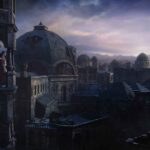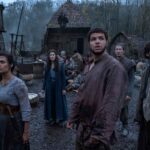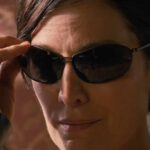In this weekly series, we chronicle the long road undertaken by the Marvel Cinematic Universe movies to arrive at Avengers: Infinity War. We introspect and discuss the movies from a critical and commercial standpoint while also considering the development efforts that went behind them. These articles may be occasionally sprinkled with spoilers so please make sure to skip the relevant sections when reading.
This post is about the 2016 movie Doctor Strange, the fourteenth chapter in the Marvel Cinematic Universe. To check out other entries in our Road to Infinity War series, click here.
Sometimes, actors are tailor-made for certain roles. In a large number of cases, we as the audience realize this much after the movie has released. Christopher Reeve as Superman, Tobey Maguire as Spider-Man, Hugh Jackman as Wolverine and Heath Ledger as The Joker are only a tiny fraction of examples where actors have embodied superheroes and villains like they were born for it. Doctor Stephen Strange is a similar case, albeit one where both fans and the media have seen only one actor in the role since the project was announced as being in development: Benedict Cumberbatch. Even before his official casting, rumors and fan-arts circulated abound showcasing general enthusiasm for the actor landing the part. And being the studio that does listen to fans, they considered Cumberbatch for quite a while. For the longest time though, scheduling conflicts threatened to deny fans of their dream casting until eventually, Marvel decided to postpone the release of Doctor Strange to work around Cumberbatch’s schedule, leading to the actor joining the MCU.
Hiring the director for Doctor Strange was a similarly tough challenge. You see, the movie was in development for almost a decade and by the time it got on the verge of going on the floors in 2014, it had several contenders for the job. Scott Derrickson impressed Marvel executives the most by creating a pre-visualization of a sequence lifted from the Doctor Strange comic The Oath that saw the Astral forms of Strange and one of the zealots fight in a hospital room as Dr. Christine Palmer operates on an injured Strange in the real world. The demonstration was like a 90-minute pitch replete with concept art, illustrations and some concept footage, all of which Scott paid for from his own pocket. It eventually took him 8 meetings with Marvel but he finally landed the coveted job of helming Marvel Studios’ most sought after origin story.
That the hiring of both the titular actor and director were the result of intense passionate discussions and inputs from Marvel Studios, the fans and the said recruits themselves is testament to how important Doctor Strange was as a movie and is as a franchise to Marvel. Besides the “big-shots” Iron Man, Captain America, Thor and The Hulk, Strange was frequently touted as being the next huge character to be introduced to the MCU. There were also plenty of whispers that Strange would go on to assume as much of an importance as Stark does right now and with Robert Downey Jr.’s retirement imminent, Marvel was essentially securing its future Downey Jr. replacement with Cumberbatch. Of course plans changed along the way and Downey Jr. went on to stay for quite a while but that didn’t lessen the importance of this movie in any way. As a fun fact, Strange was namedropped as early as in 2014’s Captain America: The Winter Soldier as one of the individuals poised to be a potential threat to HYDRA.
At its core, Doctor Strange is about an arrogant, confident, famed neurosurgeon named Stephen Strange who suffers from a brutal car accident that renders his hands unstable. Desperate for a treatment, he winds up at Kamar Taj in Nepal after witnessing a patient he once denied treating miraculously cured of an incurable condition. Initially dismissive of healing through the power of belief, The Ancient One opens up his mind and together with Karl Mordo’s help, trains him to become the Sorcerer Supreme. He ends up being unwittingly drawn into a conflict with one of The Ancient One’s former students gone rogue, Kaecilius who threatens to engulf the world into darkness in his quest for attaining eternal life.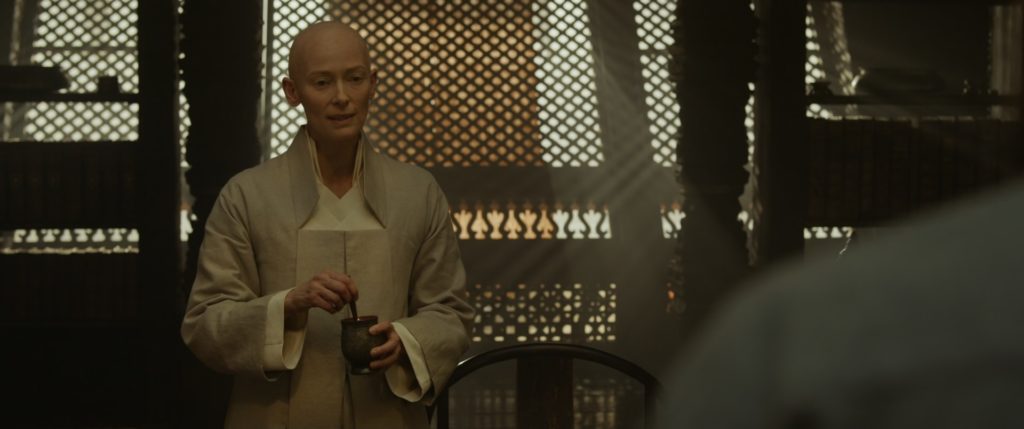 The movie itself is a straightforward origin story at its skeletal level, although director Scott Derrickson with writers Jon Spaihts and C. Robert Cargill keep the proceedings tight while infusing enough elements to make the movie stand out from its nemeses. Chief among these is their attempts at subverting genre tropes while constantly trying to come up with new stuff. This leads to the controversial casting of Tilda Swinton as The Ancient One instead of an Asian woman, young or old or even an Asian man (although this comes across more like a move to protect the movie’s box-office interests). It also leads to the Astral Plane fight sequence that Derrickson pitched to Marvel that shows up in the middle of the movie where a dramatically serious fight takes place with barely any physical consequences in the real world. All the spells seen in the movie are gesture based instead of being vocal chants. And in an extremely interesting twist of sorts, it leads to a clever use of the time-turning mechanism that sees a climactic fight in progress with the surrounding city being resurrected and rewound back to its original state instead of undergoing destruction. It’s essentially a play at the countless finales that see destruction and rubble left behind in the aftermath and instead undoes the destruction as the clash proceeds. The result is a city completely resurrected by the time the fight ends, instead of ending up with a wasteland as is the case with most flicks.
The movie itself is a straightforward origin story at its skeletal level, although director Scott Derrickson with writers Jon Spaihts and C. Robert Cargill keep the proceedings tight while infusing enough elements to make the movie stand out from its nemeses. Chief among these is their attempts at subverting genre tropes while constantly trying to come up with new stuff. This leads to the controversial casting of Tilda Swinton as The Ancient One instead of an Asian woman, young or old or even an Asian man (although this comes across more like a move to protect the movie’s box-office interests). It also leads to the Astral Plane fight sequence that Derrickson pitched to Marvel that shows up in the middle of the movie where a dramatically serious fight takes place with barely any physical consequences in the real world. All the spells seen in the movie are gesture based instead of being vocal chants. And in an extremely interesting twist of sorts, it leads to a clever use of the time-turning mechanism that sees a climactic fight in progress with the surrounding city being resurrected and rewound back to its original state instead of undergoing destruction. It’s essentially a play at the countless finales that see destruction and rubble left behind in the aftermath and instead undoes the destruction as the clash proceeds. The result is a city completely resurrected by the time the fight ends, instead of ending up with a wasteland as is the case with most flicks.
What’s also clever is the use of time-travelling and brains to defeat the foe rather than the standard sorcery and spells. To understand this, we need to take a step back and consider the motives of the movie’s antagonists. Kaecilius and his group of zealots are actually doing the dark lord Dormammu’s bidding who thrives in the Dark Dimension. He feeds on people’s fears and draws power from them. Dormammu has had his eye on Earth for a long while, but has been unable to invade it thanks to the presence of an ethereal shield generated by three Sanctum Sanctorums that reside on different parts of earth. Kaecilius helps Dormammu’s plan by taking down the Sanctums one by one so that the Dark Lord can take over earth and grant in return, eternal life. Kaecilius envisions it as a world without time. With this background then, instead of fighting Dormammu head on, Strange traps him in a time-loop that sees Dormammu stuck killing Strange repeatedly. In the end, Strange strikes a bargain with Dormammu, promising to let him out of the loop in exchange for leaving earth alone.
Interestingly the writing-directing team of Derrickson, Spaihts and Cargill ensure that everyone’s motivations come out as clearly as possible despite the limited run time of under 2 hours allotted to the movie. This was most important for an antagonist like Kaecilius, especially in wake of criticism regarding Marvel’s lackluster villains. A former student of The Ancient One, Kaecilius came to her to heal himself from the loss of his wife and children, only to grow disillusioned upon discovering what according to him was the Ancient One’s treachery. Turns out the Ancient One is able to live far too longer than any mortal can, a feat she has accomplished by secretly drawing power from Dormammu himself. When she refused to share that knowledge with her students, a distraught Kaecilius walked off promising to summon the dark lord himself. I also believe he secretly hopes to restore his lost family once he enters a world without time. This origin is not spelled out as clearly but there are bits and pieces present that I’ll admit, it took me more than one viewing to catch. Multiple viewings have thus broadened my understanding of this movie and have subsequently influenced by opinion of the same.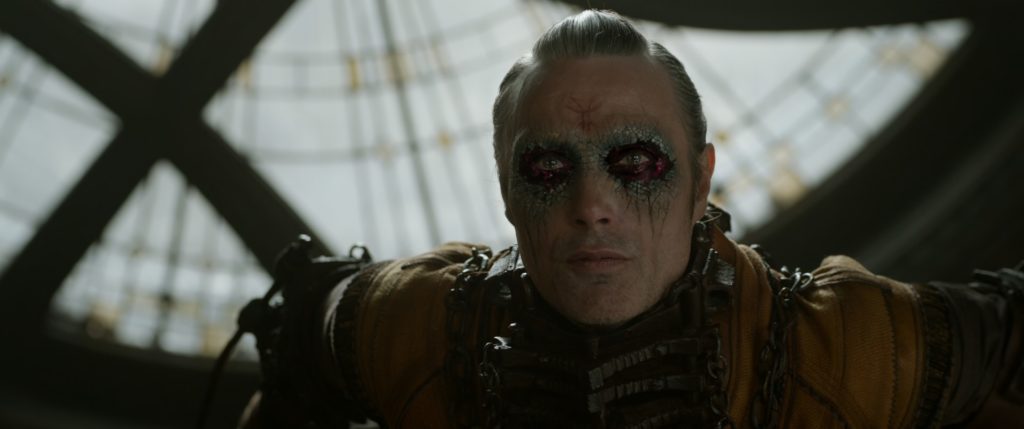 The Ancient One herself remains much of a mystery, although the movie does establish that there have been several Ancient Ones throughout history, starting from the very first – Agamotto. Agamotto is whom the Time Stone belongs to and I’m not exactly sure if he knew Odin by any chance. The other character then (besides Strange) who undergoes a strong arc is Karl / Baron Mordo. In the comics, Mordo is an outright antagonist of Strange and possibly one of his strongest and most frequently appearing enemies. In the movie, he starts off as an ally only to become similarly disillusioned with the Ancient One as Kaecilius when the former reveals the truth about her in front of him and Strange. The movie draws parallels between Mordo and Kaecilius and Mordo becomes a Kaecilius in the making. Mordo’s transition from a fiercely loyal sorcerer to a man on a mission to rid the world of all sorcerers is one of the engaging aspects of the movie and in some ways, is even better than Strange’s arc himself.
The Ancient One herself remains much of a mystery, although the movie does establish that there have been several Ancient Ones throughout history, starting from the very first – Agamotto. Agamotto is whom the Time Stone belongs to and I’m not exactly sure if he knew Odin by any chance. The other character then (besides Strange) who undergoes a strong arc is Karl / Baron Mordo. In the comics, Mordo is an outright antagonist of Strange and possibly one of his strongest and most frequently appearing enemies. In the movie, he starts off as an ally only to become similarly disillusioned with the Ancient One as Kaecilius when the former reveals the truth about her in front of him and Strange. The movie draws parallels between Mordo and Kaecilius and Mordo becomes a Kaecilius in the making. Mordo’s transition from a fiercely loyal sorcerer to a man on a mission to rid the world of all sorcerers is one of the engaging aspects of the movie and in some ways, is even better than Strange’s arc himself.
Our third and final hero Strange goes on an arc of redemption, one where he comes to terms with his ego. His transformation as the Sorcerer Supreme is complete when towards the end, a selfish man like him learns the act of sacrifice. This can be contrasted by nuggets and bits towards the beginning and end of the movie. In the movie’s opening moments, we see Strange far too cocky and protective of himself to take on any cases that could jeopardize his spotless career even though there’s the faintest of chance he might save a life. And yet, at the end, he battles Dormammu by virtue of an implausible plan that involves being stuck in a time loop for eternity, repeatedly killed by the evil monstrosity until he somehow agrees to the bargain. Had Dormammu refused, Strange would’ve ended up dying a thousand deaths. And yet, it’s a chance he’s willing to take through a seemingly impossible plan to save the millions out there who mean nothing to him. It only helps that Dormammu is voiced by Cumberbatch as well, reminiscent of him voicing Smaug in the second Hobbit installment. The ending then metaphorically brings Strange face to face with an egoistic version of himself, more akin to his past. And the plan to defeat Dormammu then, is not only decidedly clever but also gives a glimpse into a changed man, one who’s now willing to trap himself if it means the rest of humanity gets to live a normal life.
All these character arcs are supplanted and even exemplified through the use of visual effects. Unlike other movies, this one uses some trippy, psychedelic visuals to transport viewers in alternate dimensions and uses them effectively and convincingly to provide viewers a window into the world of the mystic arts. There’s an extravagant sequence to that end when The Ancient One sends a dismissive Strange on a trip to all the other gateways that the universe has to offer. It’s essentially visual effects at the level of weirdness that comics embraced and the VFX team goes all bonkers with the rich and imaginative imagery on display there. As with Strange, that 2-minute CGI trip helps open up your mind to the wonders of the universe. Another crazy sequence occurs two-thirds through the movie and is essentially Inception on steroids. Buildings fold, pathways coalesce and diverge in all sorts of twists and turns to create an urban labyrinth of mazes that unfolds dynamically against the backdrop of a chase sequence. Finally, the unique climax reconstructs the city backwards in time as our heroes fight in the present time while Strange bargains with Dormammu to leave the world at peace. Dormammu is rendered frighteningly and his environments are rich in colors and texture while the rewinding destruction is again a unique piece of visual effects savagery.
The movie is scored by the legendary Michael Giacchino who gives a fairly recognizable theme to Strange that has lots of Indian, Nepali and other Asian touches, especially when heard during the credits. It’s a central theme that plays across the movie in different variations. Editors Wyann Smith and Sabrina Plisco help keep the movie tight and pack in enough even in 1 hour 54 minutes while cinematographer Ben Davis of Guardians of the Galaxy fame provides the same sense of visual richness he did for that sleeper hit, leading to the movie looking like a visual beast. In fact, having produced over 11 movies by now, one shouldn’t expect anything less from a Marvel Studios production in terms of production qualities and the movie doesn’t disappoint to that end at all.
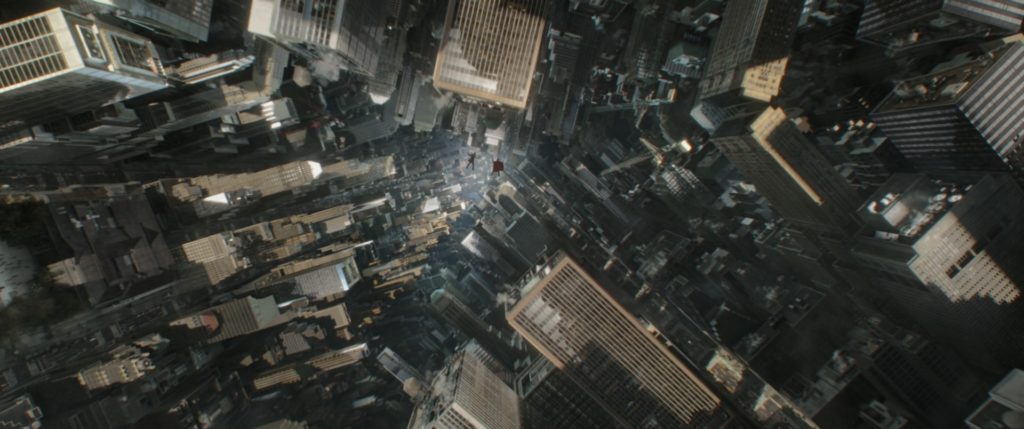 Of course it’s not without its drawbacks, and those stood out like a sore thumb for me when watching it for the first time. Strange’s training montages for instance progress way too quickly for my liking, and before you know it, he’s conjuring up portals and reading books through his Astral form as his physical form rests with relative ease and comfort. A second viewing though has made me somewhat accepting of this as I realize that a lot of Strange’s training was left incomplete and he was thrust in a situation of action against Kaecilius as he took over the New York Sanctum. Strange is basically left to fight and fend for himself which is possibly why he makes very limited use of his powers making frequent mistakes like transferring everyone to the Mirror Dimension. Rachel McAdams should’ve definitely had a more stronger presence in the movie; it feels ironic she ended up with a somewhat traditional female protagonist relegated to the backseat given how hard Derrikson were trying to subvert tropes. And lastly, Marvel’s penchant for the humor produces some odd moments when Kaecilius and Strange share a joke over the latter’s name just around the time the New York Sanctum sorcerer is killed by the former. While the exchange itself is witty, it comes at an abruptly incorrect time and takes away the seriousness of the casualty entirely
Of course it’s not without its drawbacks, and those stood out like a sore thumb for me when watching it for the first time. Strange’s training montages for instance progress way too quickly for my liking, and before you know it, he’s conjuring up portals and reading books through his Astral form as his physical form rests with relative ease and comfort. A second viewing though has made me somewhat accepting of this as I realize that a lot of Strange’s training was left incomplete and he was thrust in a situation of action against Kaecilius as he took over the New York Sanctum. Strange is basically left to fight and fend for himself which is possibly why he makes very limited use of his powers making frequent mistakes like transferring everyone to the Mirror Dimension. Rachel McAdams should’ve definitely had a more stronger presence in the movie; it feels ironic she ended up with a somewhat traditional female protagonist relegated to the backseat given how hard Derrikson were trying to subvert tropes. And lastly, Marvel’s penchant for the humor produces some odd moments when Kaecilius and Strange share a joke over the latter’s name just around the time the New York Sanctum sorcerer is killed by the former. While the exchange itself is witty, it comes at an abruptly incorrect time and takes away the seriousness of the casualty entirely
Doctor Strange managed to assemble a stellar cast that does not disappoint in any respect. Tilda Swinton plays The Ancient One with a mix of finesse and a trace of humanity evident throughout. She conveys effectively the regret over betraying Kaecilius and Mordo while shares a tender moment with Strange in one of the movie’s pivotal outcomes. Despite what the media made out of the casting, I didn’t have the slightest of problems with her playing the Sorcerer Supreme of Kamar-Taj. Mads Mikkelson tries to imbue Kaecilius with a sense of perspective so you can at least understand his point of view and largely succeeds. Chiwetel Ejiofor portrays the transition of Mordo from a hardcore loyalist to a man in doubt convincingly despite the suddenly jarring shift. He’s clearly set up as Strange’s foil in future movies and helps viewers register that transformation well enough. Finally, as mentioned previously, Cumberbatch looks born for this role and slips into the part of the Sorcerer Supreme with extreme ease. His journey from arrogance to humility, from the know-it-all neurosurgeon to a sorcerer who realizes the limitations of his knowledge and from a selfish famed man to a selfless one willing to operate in the shadows of the Sanctum is the movie’s highlight and with the right actor, the journey shines.
Doctor Strange ended up becoming Marvel Studios’ highest grossing origin movie to that point, earning $677 million against a $165 million production budget. To put that number in some perspective, it exceeded the grosses of some rather popular origin story movies such as Iron Man ($585 million), Batman Begins ($363 million) and also Man of Steel ($663 million). Both critics and audiences deemed the movie fresh, praising the visuals and welcoming Cumberbatch to the Marvel family. And fans? They simply couldn’t wait to see two Sherlock alums share screen space and witness Doctor Strange team-up with the rest of the Avengers. However, we still had a few movies to go before we reached that point. For now, after exploring and opening up the concept of the Multiverse in Doctor Strange, it was time for viewers to revisit the cosmos.


